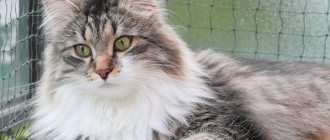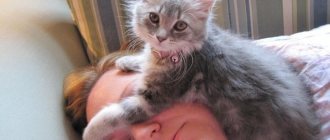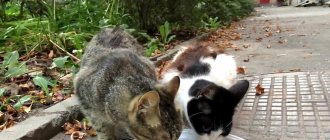A group of Swiss veterinarians and biologists conducted a series of special studies to find out how cats behave towards their owners. The results showed that with the right interaction with animals, owners can literally bask in the love of their furry pets. Joinfo.com shares 10 effective ways to improve your relationship with cats.
Let the cat come to you first
When you adopt a new kitten, don't try to shower it with all your love and care right away. Let him first get used to it, understand where to find food and toys. It’s better to watch from the side for a while: if everything is fine, the pet will come up to meet you. All you need to do is not pay too much attention to him, because cats love freedom.
How to improve your relationship with your cat?
Does your cat rarely climb on your lap or play with you as often as he used to? Your connection may have weakened, but don't break it any further. Everything can be corrected. Here are surefire ways to make you friends again and take your relationship with your cat to a higher level.
Cats are delicate and highly emotional creatures with complex personalities. They say they prefer to be alone, but every cat owner knows that this is not true. Building friendship between a cat and a person is not easy, but when it is successful, it brings a lot of pleasure. So if you want your cat to love your company and your relationship to be deep and unique, get off the couch and do something nice for him. Here are some simple tips to help you learn how to improve your relationship with your cat.
Contact the cat
Work, family, shopping, cleaning. Household and family responsibilities consume you completely. Where can you find time for your pet during this time? A cat knows very well when it is being ignored and when a person does not want its presence. And this is the easiest way to break the connection. Give your cat more attention every day. And start from the very entrance to the house. Greet the furry one with a smile, pet it, feed it. Let your cat know that you like him and are pleased to see him.
During the day, do not miss the presence of the cat. Whenever you pass by a cat, say something nice to him, scratch him behind the ear. Sit him on your lap while watching TV or reading a book. Don't get angry with him when he drops the glass, and don't chase him from place to place. Such actions will quickly pay off. And you will not notice how you will become the cat's favorite person in the house.
Path to the Heart
You are what you eat. This principle also works for cats, but it is up to you, for example, what goes in the cat's bowl. A proper diet not only ensures your cat has a healthy and long life, but also satisfies her basic needs and gives her the energy to play.
Choose grain-free products that contain a lot of meat, such as chicken breast fillet, rabbit, and lamb. It is also worth feeding cat food rich in fish, such as salmon or tuna. It contains fatty acids that have a beneficial effect on the pet's nervous system. Before buying food, be sure to read its composition on the package and the amount that should be given to your cat, because feeding from the heart does not mean much, but wisely.
Say no to boredom
Don't let your cat get bored. How? Have fun with her. Having fun together is one of the best ways to improve your relationship with your cat. Twice a day for 15-20 minutes is enough to make the animal feel pampered and satisfied. You can play with your pet using a fishing rod, you can put boxes for the cat to jump into, or just throw a wad of paper or candy wrapper to chase it. There are many possibilities. And they do not require financial costs. Just fantasy and desire.
It's never too late to learn to walk on a leash. And this is a direct way to start walking. Perhaps in a few weeks you will be traveling around the world (or just the surrounding meadows and parks) together in search of adventure.
Make sure you are properly hydrated
Many cats are reluctant to drink water, and this has a negative impact on their health. And a cat that is worried about something will not want to deepen its connection with you. As a responsible guardian, you must ensure that your cat is hydrated well. The water in your cat's bowl should always be fresh (it's best to change it every day), and the bowl itself should be clean. Don't limit yourself to one source of water. To encourage your cat to drink, place several bowls around the apartment, preferably in areas where the cat is likely to stay longer. However, the water should be kept away from the toilet - no one likes drinking in the toilet, right? Also, the drinking bowl should be installed away from the food bowl (cat nature).
There are cats that prefer to drink running water, but they are not at all interested in the water that is in a bowl. See if your cat is one of these. If so, buy her a cat fountain. You can also turn off the faucet and let your cat drink directly from it. Also, encourage your cat to eat wet food. The cat will feed on it and, due to its moist consistency, the right amount of water will enter the cat's body. A hydrated cat is lucky.
Is your relationship with your cat improving? Work!
Now you know what you need to do to improve your relationship with your cat. It's not that difficult, right? And the consequences will certainly exceed your expectations. You are one step away from purrs, butts and cat massages just for you. Well, will you try it?
Why can't domestic cats growl?
Why can't domestic cats growl? Although our cats will try very hard, the only thing they can do is meow... Tag "Next"
Do cats manipulate us? The cat meows like a baby to get what it wants!
Do cats manipulate us? The cat meows like a baby to get what it wants! A cat meows for various reasons. But one thing... Tag “Next”
What makes you disgusted with cats?
What makes you disgusted with cats? Apparently cats and people either love or hate each other. It’s hard for us cat lovers to understand why... Tag “Next”
Why do black cats change color? Here are 6 reasons
Why do black cats change color? Here are 6 reasons why is your black cat starting to lose its original color? Have you noticed that his... Tag “Next”
8 Most Emotional Cat Breeds
8 most emotional cat breeds They will win your heart not only with their appearance, but also with their behavior. The cats of these... Tag "Next"
Why doesn't the cat kneel? Can this be changed?
Why doesn't the cat kneel? Can this be changed? Some cats avoid human laps at all costs. Why? Can you... Tag "Next"
Jealous cat. How to fight?
Jealous cat. How to fight? A jealous cat can cause a lot of trouble for a household. To make matters worse, he suffers from it too... Tag "Next"
How to recognize cat pain in advance?
How to recognize cat pain in advance? As it turns out, a cat's facial expressions can give us subtle tips about more than just the well-being... Tag "Next"
Why do cats love heights?
Why do cats love heights? Find out why cats love heights and how to create a cat-friendly jungle at home. You are holding a cat... Tag "Next"
Why does a cat wash itself as soon as you pet it?
Why does a cat wash itself as soon as you pet it? It is worth remembering that licking in cats is not only grooming... Tag “Next”
Set up a place to relax
A cat needs a personal space where it can go if it doesn’t like something and calm down there. If she scratches, bites and wags her tail in displeasure, do not hold her near you. Let yourself come to your senses, wait until she approaches you again. By doing this, you show her that you respect her interests - and she will respond with even greater affection and devotion.
Eye contact
Cats do not tend to communicate with humans through voice, except in rare cases.
The main way of communication between a kitten and a person is visual contact. To let your pet know that there is no danger, he is loved and accepted, you can use the following methods of conveying information: We also recommend reading:
The largest dog breeds What is domestication in animal husbandry Why you should get a cat: reasons voiced by scientists Euthanasia of animals
- cats do not like direct eye contact, so they often seek communication with those who are indifferent to them and do not pay attention;
- if the kitten is in a calm state, try to lie next to it and look into the baby’s eyes, after responding with the pet’s gaze, slowly close your eyes, then open them (do this repeatedly). You need to wait until the kitten repeats the owner’s movements;
- During exercises with closing your eyes, you need to ensure that the cat turns away, making it clear that he does not see you as a threat (this does not always work the first time).
Do not try to look into the animal’s eyes for a long time; they may take this gesture as a signal for aggression or attack. Cats are not as attached to their owner as dogs. Therefore, you should not expect them to want to constantly be near a person.
Prohibited techniques in communication
In order for your furry baby to adapt quickly, you need to know what not to do when interacting with an animal:
- do not touch the animal’s belly unless you are sure it wants it;
- give up the desire to drag your pet by the tail;
- It is forbidden to hit children; they are capable of taking revenge for an insult.
To establish contact, treat the animal as a member of the family - play with it, comb it, show care and affection. Remember the need for adequate nutrition for a rapidly growing body.
Mechanism of cat hissing
Hissing is a vibration produced by the vocal muscles located in the lower region of the larynx. The sounds are produced during forced exhalation, when the individual moves the lower jaw forward and extends the tongue.
All representatives of the cat family are capable of producing such guttural sounds, but only some breeds can growl or roar. For example, the British, Sphynxes, Maine Coons do not just hiss, but growl very loudly, expressing negative emotions.
A negative reaction is also confirmed by external signs demonstrating irritation and an outburst of emotions. At the moment of aggression, the fluffy:
presses ears tightly to head;
pushes his mustache forward;
closes his eyes, while clearly focusing his gaze;
raises the fur on the withers, tail and along the ridge.
At this time, the animal’s pupils dilate and occupy almost the entire iris. The pet's gaze expresses the entire emotional state. An owner who has carefully studied the habits of his mustachioed friend will be able to explain the specific reaction without difficulty.
Kids begin to show character quite early, thereby expressing their feelings. Kittens make guttural sounds, but weak vocal muscles make them unclear and sound more cute than scary. Their hissing does not come out at all - only the sound of exhalation is obtained.
What to do if your cat is stressed after moving?
There are several ways to do this. The first is the use of phenibut-based drugs for animals in the form of drops or tablets (for example, “Stop-Stress”). It is necessary to start taking them 3-4 days before moving, since the effect is cumulative. The second method is cat pheromones (for example, “Feliway”, “Relaxivet”).
Interesting materials:
What is the root of the word caress? What is the root of the word tomato? What is the root of the word constantly? What is the root of the word to suggest? What is the root of the word flew? What is the root of the word cool? What is the root of the word space? What root in the word should we use? What is the root of the word wheat? What is the root of the word chick?
Common Causes
If you figure out why your pet shows negative emotions, you can avoid conflict and even traumatic situations.
Defense: self, cubs or territory
Not only dogs, but also cute fluffies are able to protect themselves, kittens or their territory from surrounding people or animals. The adult feels like the owner of the home, and therefore experiences irritation if someone wants to encroach on it.
The furry friend will use terrifying sounds to drive uninvited guests out of his territory. Mothers are especially active, who in this way try to drive the stranger away from the nest with kittens.
Manifestation of fear
Specific sounds can be caused by certain fears of the cat, which are usually associated with insufficient socialization or regular physical punishment. The fact that deviations in behavior are provoked by a feeling of fear is indicated by warning poses (standing sideways, half-turned), attempts to inflict injury with claws, and subsequent demonstrative licking of the fur.
A pet may hiss at a vacuum cleaner, at loud guests, or at an unexpected sound or touch. Fright is often accompanied by a fluffy tail.
Aggression
Sometimes a cat's hissing is explained by an aggressive attitude aimed at a specific person or animal with which negative memories are associated. For example, a guest could step on a tail, paw, or offend during a previous visit. Or the neighbor's dog is constantly trying to catch up and sniff the mustache.
The owner himself is capable of provoking aggression. Sharp shouts, frightening gestures or trips to the vet are good enough reasons for a mustachioed friend to hiss. If a pet has not experienced tenderness and affection from a person since childhood, then he will begin to scream and hiss at him during any attempts to get closer.
Unmotivated aggression is often caused by sexual desire or hormonal imbalance. If a cat hisses at everything for no reason or reason, it is better to take him to the vet and have him neutered. The same applies to females.
Illness or state of anesthesia
If a gentle and affectionate purr begins to demonstrate repeated aggressive behavior, this may indicate the presence of health problems. Among the diseases that accompany inadequate reactions are:
food and chemical poisoning;
An injured animal, in pain, will hiss and growl at a person who wants to help. Operated pets who have not fully recovered from anesthesia and have lost the ability to navigate in space react the same way.
Trying to communicate something
Sometimes a cat is forced to hiss to attract the owner's attention. This happens after the mustachioed friend repeatedly meowed to the person, but he did not respond. In this case, the fluffy feels displeased and makes frightening sounds.
This behavior is most often demonstrated by poorly raised or overly spoiled pets. If the mustache constantly behaves this way, then measures must be taken to re-educate it.
Why do cats hiss: at humans and at each other?
A predator that hisses at people and other animals awakens from time to time even in an affectionate and gentle pet. Any representative of the cat family has the blood of a wild ancestor, so deviations in behavior accompany the mustachioed pet throughout its life. Owners need to understand what provokes such manifestations of aggression and know how to deal with them.
Pay attention to what they tell you
Taking notice of their meows when their cup is empty is one thing, but cats are also masters of body language. They will tell you everything you need to know about how they are feeling with simple movements of their tail or body. If cats are rolling around on the floor and looking at their owner with friendly-sounding vocalizations, there is a good chance that they are being friendly. A pet's tummy turned towards you is usually a sign that he feels comfortable.
His films still make people laugh: what happened to the 3 sons of Louis de Funes
NASA discovered a snake-like exoplanet with its own atmosphere
Using a radio telescope, astronomers looked at the “cosmic jellyfish” for the first time
True, the most important indicator is always the tail. Reading this cat language may seem difficult at first. But over time, it becomes easier to understand the difference between when they are in the mood for your affection and games, and when they are not so much. And they can be understood. If someone always annoyed you relentlessly when you weren't in the mood, would you like it?
Below are tips on how you can tell your cat's mood by looking at its tail.
- If your pet's tail is straight up and not curled, it most likely means that he is friendly and may even greet you by rubbing against your leg or arm.
- If the tail is curled down and slightly raised, the cat is likely to be aggressive or defensive.
- If the tail swings around at random, the animal is probably irritated or angry and would prefer to be left alone.
- If only the tip of the tail bends slowly back and forth, it may mean that your pet is curious, preoccupied, or interested in something specific.











